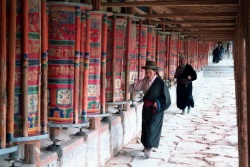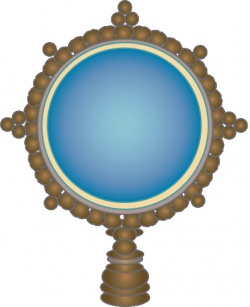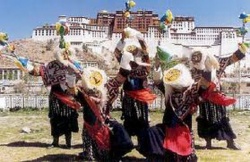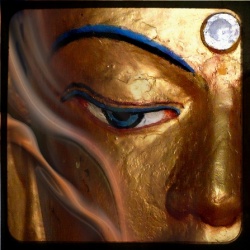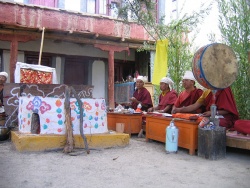About Prayer Wheels
The ancient texts tell us that the Prayer Wheel was brought to our world by Nagarjuna, a famous Indian Buddhist scholar, philosopher, and yogi. Nagarjuna is associated with the rise of Mahayana Buddhism during the first century B.C.E. and is well known as the founder of the Middle Way school of Buddhist philosophy - which all currently existing schools of Tibetan Buddhism accept as the most profound of all philosophical views. Nagarjuna was filled with great compassion and
concern for others. He was an extremely gifted and intelligent teacher who thought continually about how to best benefit others. Nagarjuna’s teachings not only began one of the greatest philosophical traditions of all time, but also contributed immeasurably to a cultural transformation that spread the Mahayana Buddhist vision of universal responsibility and compassion for all life throughout most of Central and East Asia.
The prayer wheel lineage was brought to Tibet by the renowned eight century Indian Buddhist teacher Padmasambhava, and later practiced by the great Indian tantric Buddhist masters Tilopa and Naropa. Naropa’s disciple Marpa later
renewed the lineage in Tibet and passed it on to Tibet’s most well known yogi, Milarepa. Since that time the Prayer Wheel has been passed on through a continuous lineage of enlightened teachers, among these the great Kagyu master Karma Pagshi, whose important works are quoted by most subsequent writers on the subject.
In Tibet, Prayer Wheels have been made for many centuries in a wide range of sizes and styles - from hand-held and table-top wheels, all the way up to giant eight or twelve foot Prayer Wheels with diameters of five to six feet. Often built around Buddhist Stupas
and Monasteries, there may be long rows of prayer wheels which people will spin as they walk clockwise around the building, reciting what is considered to be one of the most profound and beneficial mantras;
mantra OM MANI PADME HUM
In the translation of a text by the Fourth Panchen Lama, Amitabha Buddha says “Anyone who recites the six syllables while turning the dharma wheel at the same time is equal in fortune to the Thousand Buddhas.” In the same text Shakyamuni Buddha says that "turning the prayer wheel once is better than having done one, seven, or nine years of retreat" The prayer wheel is a very powerful merit field; one accumulates extensive merit and purifies obstacles.
It has been well known for over a thousand years by the great Buddhist yogis and teachers as well as the Tibetan people that the prayer wheel practice is an extremely quick, simple and profound method for developing compassion and wisdom. Buddhist teachers and the ancient texts expound the profound benefits of the Prayer Wheel for its ability to quickly harmonize the environment, increase compassion, encourage a peaceful state of mind, and assist practitioners on their journeys to enlightenment.
It is suggested that one recite the six-syllable mantra – Om Mani Padme Hum – while turning the prayer wheel. The Tibetan commentaries state that the benefits of doing so are immeasurable. This is the mantra of Avalokiteshvara, the Buddha of
Compassion, and it is recited continually by many Tibetans. One also finds it carved on rocks, written on prayer flags, embossed on jewelry, and inside of most prayer wheels. Among Tibetans it is commonly known as the mani mantra, and thus prayer wheels are often referred to among Tibetans as mani wheels.
Mantras are strings of syllables empowered by enlightened beings to benefit others. “The word mantra’ means ‘mind-protection’. It protects the mind from ordinary appearances and conceptions” that characterize the ongoing cycle of samsaric suffering. Different mantras are said to bring different benefits, with regard to the mani mantra, Kalu Rinpoche notes that
it is “extremely powerful” and “can be used by one and all” to speed their path to enlightenment. His Holiness Dilgo Khyentse Rinpoche wrote, “The mani is not just a string of ordinary words. It contains all the blessings and compassion of Avalokiteshvara,”
The role of mantras in Buddhist practice is often not well understood in the West. It has been scientifically documented that mantra recitation produces significant psychological and physiological relaxation, and statistical analyses have shown that meditation with traditional mantras produces a greater reduction than other kinds of meditation (including
mediation with randomly selected Sanskrit syllables or with personally selected English words). Westerners have tended to emphasize the relaxing effect of mantra recitation in their understanding of this practice. From a Tibetan Buddhist perspective, such relaxation is not the goal of mantra recitation; rather it is a positive but minor side effect.
“In solitary stony fastness among the mountains, there is a strange market..where one can barter the vortex of life, for boundless bliss”
It is important that the prayer wheels be properly made. We have found that many of the prayer wheels available for sale these days in Asia and the West are rarely filled or made properly. They are usally being sold as tourist items. Often the prayer wheels are filled incorrectly, with mantras printed unclearly, upside down or inside out. As the Buddhist commentaries explain, the use of
such improperly filled wheels is unlikely to bring about the desired effects. Thus it is important to be sure that your prayer wheel has been verified to be properly filled with the proper mantras, including the earth and sky wheel mantras that go on the top
and bottom of all authentic prayer wheels.
mantras are rolled facing outwards
Prayer wheels are usually filled with the mantra of Avalokiteshvara, the Buddha of great compassion. OM MANI PADME HUM. So much of the spiritual power of the prayer wheel derives from the power of this sacred mantra that by connecting with the energy of the prayer wheel one is connecting with an outer manifestation of unlimited enlightened compassion, and is awakening one’s own highest potential - one’s Buddha nature.
eath wheel mantraUltimately, the subject of mantras and of how they function in Buddhist practice is extremely vast and profound. The important thing to understand here is that the mantra is not a prayer to a divine being; rather, the mantra -
whether recited, written or spun - is enlightenment immediately manifest. In turning the prayer wheel and reciting the mani mantra, one is essentially attempting to put a full stop to the impure, samsaric world based on ignorance and self-centered attitudes. One is asserting with one’s body, speech and mind, that enlightenment is manifest here and now. That this is a pure Buddha-land and that the universe is filled with brilliant light of compassionate wisdom manifest everywhere in order to awaken all beings.
The Prayer wheel is also a truly excellent way to help harmonize and Feng Shui your environment, increasing the positive energy in your home or workplace. A number of Tibetan commentaries state that having a prayer wheel in a building makes
that place become like the Potala - the pure land of the Buddha. People that own prayer wheels all agree that having one near them in theirhome feels wonderful. The prayer wheel’s beauty and energy really does have a very clear and positive effect.
Robert Thurman, well known Professor of Indo-Tibetan Buddhist Studies in the Department of Religion at Columbia University notes that when Tibetans recite the mani mantra, they are in effect saying,"All is well. Everything is perfect. Wisdom and compassion uphold every atom!"
Sacred objects like prayer wheels help one to develop positive qualities in/of the mind. Buddhist teachers emphasize how everything comes into being based on causes and conditions, and developing positive inner qualities depends on many causes and conditions, including environmental factors. Many people have noted how having a prayer wheel near them helps them
meditate more effectively, or to more easily develop positive states of mind. Most Tibetans may have began using their prayer wheels based on faith, but continued to engage in the practice throughout their lives based on their own experience of it leading to more peaceful, joyful, and virtuous mental states.
spin prayer wheelThe Traditional Prayer Wheel Practice - Is to spin the prayer wheel in a clockwise direction, recite the mantra OM MANI PADME HUM and visualize pure white light rays being emanated out from the spinning prayer wheel, this pure light comes from the millions of mantras inside the prayer wheel and goes out to ourselves and all
sentient beings, purifying, healing, completely illuminating everyone, as the light rays spread throughout the whole vast universe we all instantly become awakened and realize the Four Immeasurables of Love, Compassion, Joy and Equanimity.
If you possess one quality, it would be as if you had all enlightened qualities in the very palm of your hand. Which quality? Great compassion.
Wheel of Great Compassion
The Wheel of Great Compassion is the first Book to provide Western readers with a complete understanding of the
prayer wheel—an ancient and profound practice that has long been popular with Buddhists throughout Tibet and now in the West - for its ability to bless the environment, promote healing, increase compassion, and assist practitioners on their journeys to enlightenment.
Offering detailed description of the visualization practices and explanation of the myriad benefits of having and using a prayer wheel. It offers a clear description of prayer wheel practice, its meaning and benefits, and its role as an essential ritual and
symbol of Tibetan Buddhism. It contains a introduction to the prayer wheel, photographs and illustrations.The Wheel of Great Compassion offers several commentaries by renowned Buddhist teachers, including Lama Zopa Rinpoche and the Fourth Panchen Lama.
